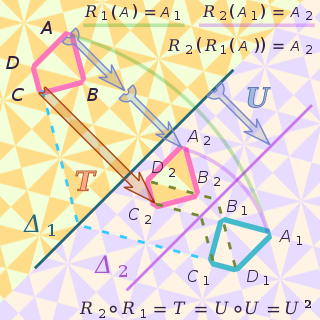In operator algebras, the Toeplitz algebra is the C*-algebra generated by the unilateral shift on the Hilbert space l2(N). [1] Taking l2(N) to be the Hardy space H2, the Toeplitz algebra consists of elements of the form
C∗-algebras are subjects of research in functional analysis, a branch of mathematics. A C*-algebra is a complex algebra A of continuous linear operators on a complex Hilbert space with two additional properties:

The mathematical concept of a Hilbert space, named after David Hilbert, generalizes the notion of Euclidean space. It extends the methods of vector algebra and calculus from the two-dimensional Euclidean plane and three-dimensional space to spaces with any finite or infinite number of dimensions. A Hilbert space is an abstract vector space possessing the structure of an inner product that allows length and angle to be measured. Furthermore, Hilbert spaces are complete: there are enough limits in the space to allow the techniques of calculus to be used.
In functional analysis and related areas of mathematics, a sequence space is a vector space whose elements are infinite sequences of real or complex numbers. Equivalently, it is a function space whose elements are functions from the natural numbers to the field K of real or complex numbers. The set of all such functions is naturally identified with the set of all possible infinite sequences with elements in K, and can be turned into a vector space under the operations of pointwise addition of functions and pointwise scalar multiplication. All sequence spaces are linear subspaces of this space. Sequence spaces are typically equipped with a norm, or at least the structure of a topological vector space.
where Tf is a Toeplitz operator with continuous symbol and K is a compact operator.
In operator theory, a Toeplitz operator is the compression of a multiplication operator on the circle to the Hardy space.
In functional analysis, the concept of a compact operator on Hilbert space is an extension of the concept of a matrix acting on a finite-dimensional vector space; in Hilbert space, compact operators are precisely the closure of finite-rank operators in the topology induced by the operator norm. As such, results from matrix theory can sometimes be extended to compact operators using similar arguments. By contrast, the study of general operators on infinite-dimensional spaces often requires a genuinely different approach.
Toeplitz operators with continuous symbols commute modulo the compact operators. So the Toeplitz algebra can be viewed as the C*-algebra extension of continuous functions on the circle by the compact operators. This extension is called the Toeplitz extension.
By Atkinson's theorem, an element of the Toeplitz algebra Tf + K is a Fredholm operator if and only if the symbol f of Tf is invertible. In that case, the Fredholm index of Tf + K is precisely the winding number of f, the equivalence class of f in the fundamental group of the circle. This is a special case of the Atiyah-Singer index theorem.
In operator theory, Atkinson's theorem gives a characterization of Fredholm operators.
In mathematics, a Fredholm operator is an operator that arises in the Fredholm theory of integral equations. It is named in honour of Erik Ivar Fredholm.

In mathematics, the winding number of a closed curve in the plane around a given point is an integer representing the total number of times that curve travels counterclockwise around the point. The winding number depends on the orientation of the curve, and is negative if the curve travels around the point clockwise.
Wold decomposition characterizes proper isometries acting on a Hilbert space. From this, together with properties of Toeplitz operators, one can conclude that the Toeplitz algebra is the universal C*-algebra generated by a proper isometry; this is Coburn's theorem.

In mathematics, an isometry is a distance-preserving transformation between metric spaces, usually assumed to be bijective.
In mathematics, a universal C*-algebra is a C*-algebra described in terms of generators and relations. In contrast to rings or algebras, where one can consider quotients by free rings to construct universal objects, C*-algebras must be realizable as algebras of bounded operators on a Hilbert space by the Gelfand-Naimark-Segal construction and the relations must prescribe a uniform bound on the norm of each generator. This means that depending on the generators and relations, a universal C*-algebra may not exist. In particular, free C*-algebras do not exist.

